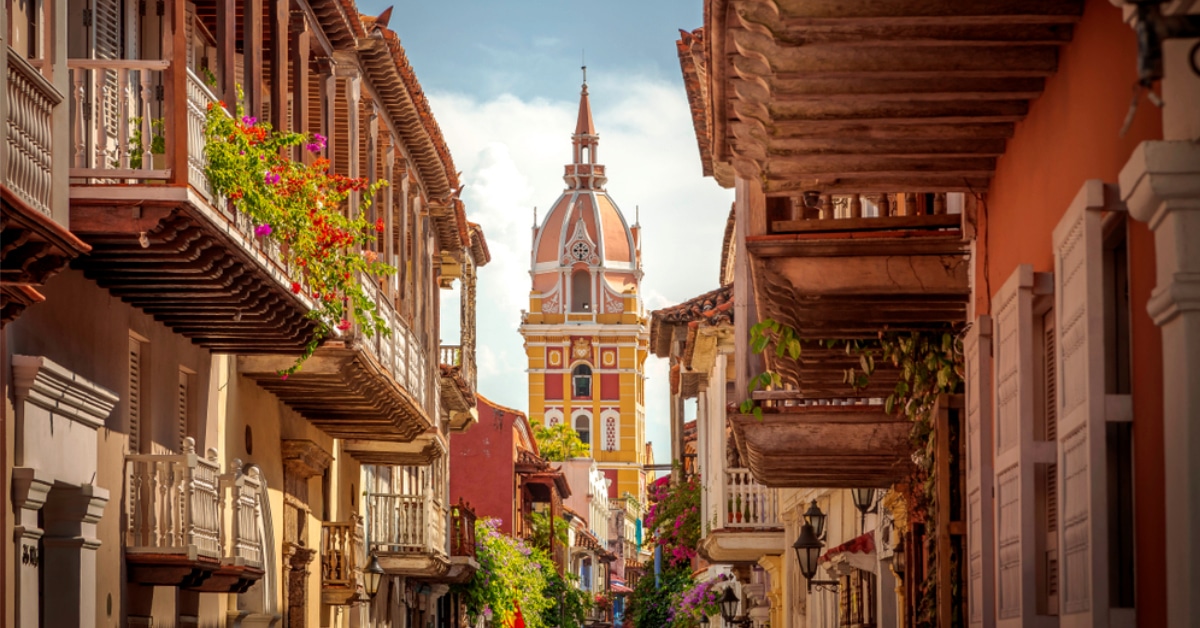Colombian Regional Accents
In Colombia, some multiple dialects and accents stray to a lesser or greater extent from Standard Spanish grammar, vocabulary, and pronunciation. Here’s a list of the different Colombian regional accents. So, be sure to explore these regions when you travel to Colombia, or while making a fun visit to YouTube!
Rolo or Bogotano
You can hear this accent in the country’s capital, Bogotá, and its surroundings. Their speech uses usted and shows a lot of politeness and formality. Thus, it is normal to hear people say things like ¿Podría por favor abrir la ventana? (Would/May you please open the window).
Unlike Costeños, they pronounce all letters, including Ss and Ds at the final syllable of words. However, they do add a little more stress at the end of words, and occasionally have a rising intonation at the end of sentences. The Rolo accent is very clear, therefore, it’s the preferred accent on national TV and radio. You can listen to the Bogotano accent in these interviews of singers Fonseca (the guy with short hair) and Ilona.
Paisa
This way of speaking comes from the area of Antioquia, where the nearest city is Medellín. Colombians speak Paisa in the departments of Antioquia, Caldas, Risaralda, and Quindío. Paisas have many regional and local expressions that are opaque even to other Colombians. Among the most notable features of the Paisa dialect are the voseo and their phrasal intonation or cantaíto/cantadito (singsong). They drag out the end of sentences in a peculiar tonal rise and fall. Besides, they pronounce S as a whispered SH.
In this video, you can hear Violeta, a local Spanish teacher, speak the Paisa dialect. If you enjoy memes and viral videos, then you’ll certainly have a sadistic pleasure time listening to Doña Gloria cursing everybody for taking her on a trip to heights in metro cable. The Paisa accent may not always be pretty.
Valluno or Caleño
You can hear it in the area of Valle del Cauca, located in southern Colombia, where the nearest major city is Cali. They use the vos form and they have a particular way to conjugate verbs. For instance, they say vení instead of ven (come here). You can learn this conjugation by watching the mafia-based soap opera/drama “El Cartel de Los Sapos” (“The Snitches’ Cartel”).
The Caleño dialect uses voseo and often changes intervocalic S sounds for an H sound. This is known as jejeo (HEH-HEH-OH). For instance, a Valluno pronounces necesitar as NEH-HEH-SEE-TAR and Los hombres as LOH-HOM-BRES. Besides, when an N is at the end of a sentence, Vallunos change it to an M. For example, Voy a comprar pan. Here, the “pan” is pronounced as “pam”. If you prefer dancing instead of sitting in front of your laptop, you may also learn that Cali is the home of the Salsa Caleña, a treasure of the local culture. In this video, filmmakers ask people from Cali why they are so good at dancing salsa.
Pastuso or Andino
It comes from the Southwest region of Colombia, where the major city is Pasto, located in the department of Nariño. Pastuso dialect has a strong indigenous influence, so they adopted many words from the Quechua language. Namely, achachay for cold, cuiche for rainbow, and guato for small. The R is similar to the one in Chile, assibilated, or a hissing sound. The S, on its part, is never omitted but vowels may be weakened to emphasize consonants. This adorable video shows an Andean male proud of his Pastuso accent.
Costeño or Caribeño
The Costeño accent is from the Northern Coastal area of Colombia, near the Caribbean. It’s the least comprehensible for foreigners. Why? Because Costeño is heavy on local slang, people speak it impressively quickly, and many words are half-pronounced. Costeños realize final N words as velar (or the NG in sing).
Plus, they aspire the Ss at the end of syllables, making them sound like a weak English H. Thus, costa and más o menos sound like “cojta” or “majomenoj” in Costeño Spanish. Besides, Caribeños skip the D in words ending in -ado. For instance, you’ll hear “pesca’o” instead of pescado (fish) or “pela’o” instead of pelado (slang for boy or guy). There’s a popular girl on social media called “Martina La Peligrosa” that teaches the Costeño accent from Córdoba, Colombia.
Chocoano or Pacífico
The Pacific region of Colombia is home to a great diversity of ethnic groups that converge on the Chocoano dialect. Its name comes from the department of Chocó, on the Pacific coast. This accent reflects African influence in terms of intonation and rhythm. Similar to the Costeño dialect, Chocoano speakers omit the syllable-final S or debuccalize it and pronounce it as H. Thus, you’ll hear “e’to señore” instead of estos señores.
You can also hear this dialect in the speech of Afro-Colombians living in the departments of Cauca and Valle del Cauca. Have a quick listen to some local residents that participated in a documentary about the Pacific region.
Isleño or Insular
It’s the accent from the Colombian islands located in the Caribbean; San Andrés, Providencia, and Santa Catalina. This dialect is a mixture of Caribbean Spanish (Costeño) and British English. Hence, their R is the English R. Besides, they aspire S a little bit. Thus, words, like invierno becomes [imˈbjeɹno]; and escarlata (scarlet) becomes [ehkaɹˈlata].
You could say this dialect is also similar to Nicaraguan Spanish due to the proximity of the Colombian islands to this country. Additionally, Isleños also speak Caribbean English and a type of Creole that mixes English, Spanish, Kwa, and Igbo. This gentleman from San Andrés talks proudly about the use of these languages in the region.
Cundiboyacense
It is spoken in the departments of of Cundinamarca and Boyacá, also known as Altiplano Cundiboyacense [altiˈplano kundiβoʝaˈsense]. In English, Cundiboyacense High Plateau. The main characteristic of this dialect is the use of the word sumercé, which is a shorter way of saying su merced. The literal meaning of this word or phrase (if told separately) is “your grace”.
This is a term that dates back from colonial times and it conveys courtesy and respect. Nowadays, Colombia doesn’t use the Spain Spanish noun vosotros but people kept using su merced. You can listen to a lady speaking the Cundiboyacense dialect at minute 2:00 of this video.
Opita, Tolimense, or Huilense
This dialect is spoken in the departments of Tolima and Huila, located in the Central and Southern parts of the Magdalena River Valley. It has a slow tempo and unique intonation. Opita speakers use the pronoun usted and, in the rural areas, add the letter V to it and say vusted.
They also change common hiatuses and diphthongs of Spanish. For instance, the combinations /ea/ become /ia/ and /eo/ become /ie/. In this way, we have that Opita speakers change the word pelear (to fight) for “peliar” and peor (worse) for “pior”.
Santandereano
It is spoken in the Northeastern part of the country that borders Venezuela, the Santander, and Norte de Santander departments. The most common feature of this dialect is the dominance of usted in both formal and informal contexts.
Therefore, in this region, it is pretty rare to hear the pronoun tú. They also practice yeísmo, so words like calló and arrollo sound like “cayó” and “arroyo” in this region. The prosody of their speech features staccato, which makes the accent sound angry or rough.
Llanero
The Llanero dialect is spoken in the Eastern Plains of the country throughout the Meta, Casanare, Arauca, and Vichada departments. The most relevant feature of this dialect is that it suppresses the final S of plural phrases, making it sound like a soft /h/. For example, a Llanero that reads Los padrinos will say “lo[h] padrino”. Colombian Llanero tends to compose words such as pativoltiao. This stems from the combination pata (leg) + volteado (flipped).
Amazónico
Just like its name suggests, it’s the dialect of the Amazonian region of Colombia. You can hear it in the jungles of the Southwest of the country: Caquetá, Vaupés, Amazonas, Guaviare, Guainía. Amazónico dialect speakers turn the J into a voiceless bilabial fricative, or F sound. We represent this sound by /ɸ/, according to the IPA. This change takes place especially when the J is next to /u/.
Therefore, Los fríos de San Juan become “Los fríos de Sän Fan”. They also omit some vowels, so Nos vemos el jueves becomes “Nos vemos el feevs”. Additionally, they make Spanish vowels longer than usual, which doesn’t affect words’ meaning. At the minute 3:00 of this video you listen to an indigenous speak the Amazónico dialect.
Do Want to Perfect your Colombian Regional Accent?
Then, it would be best if you worked with one of our dialect coaches. At TruFluency, we help you design your speech according to your needs. Hence, we provide you with strategies to feel more confident, enhance your speech clarity, communicate effectively, and propel your life goals.
Our accent coaching is an active part of our Colombian Spanish lessons, so go ahead and book a lesson with one of our Spanish tutors!





